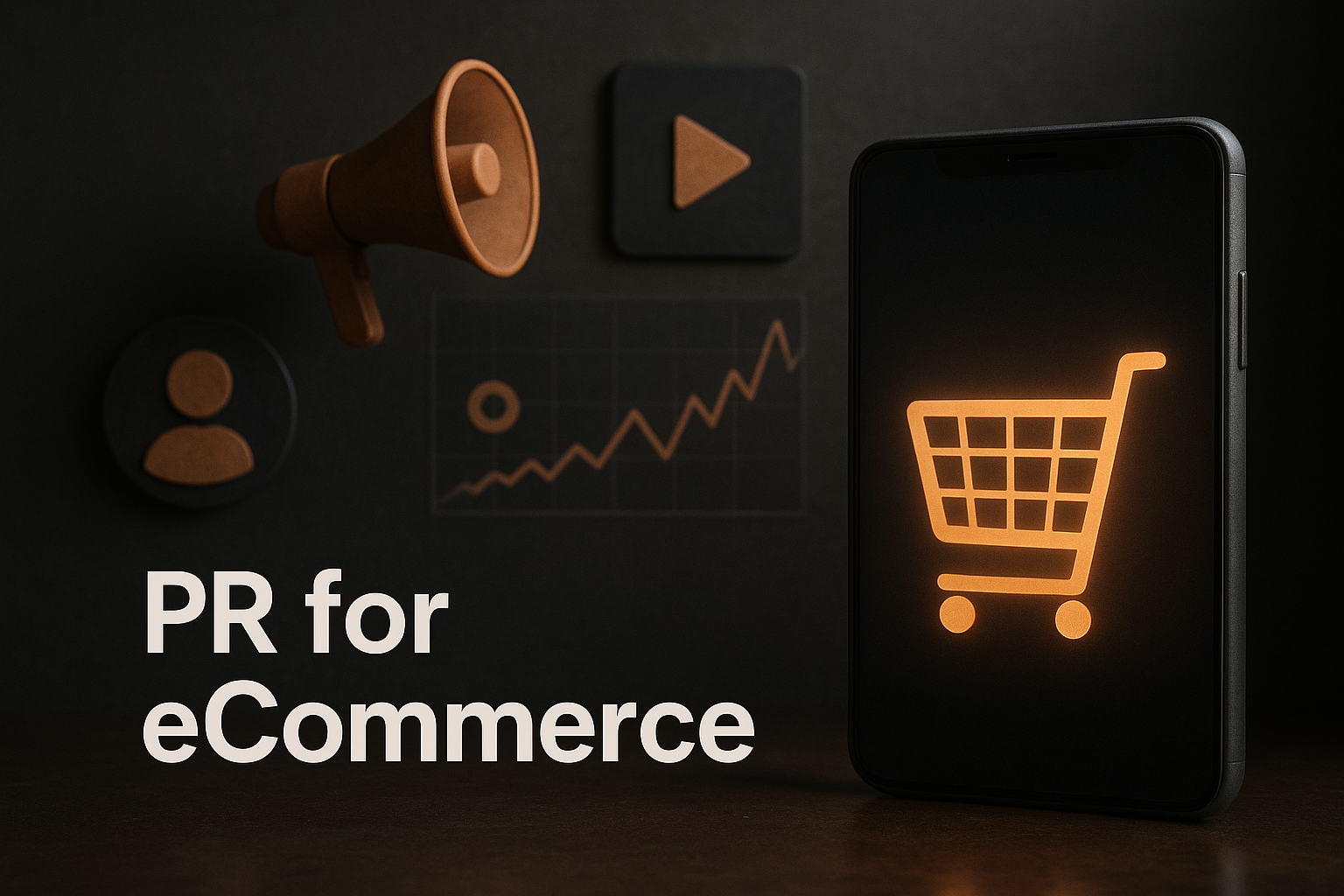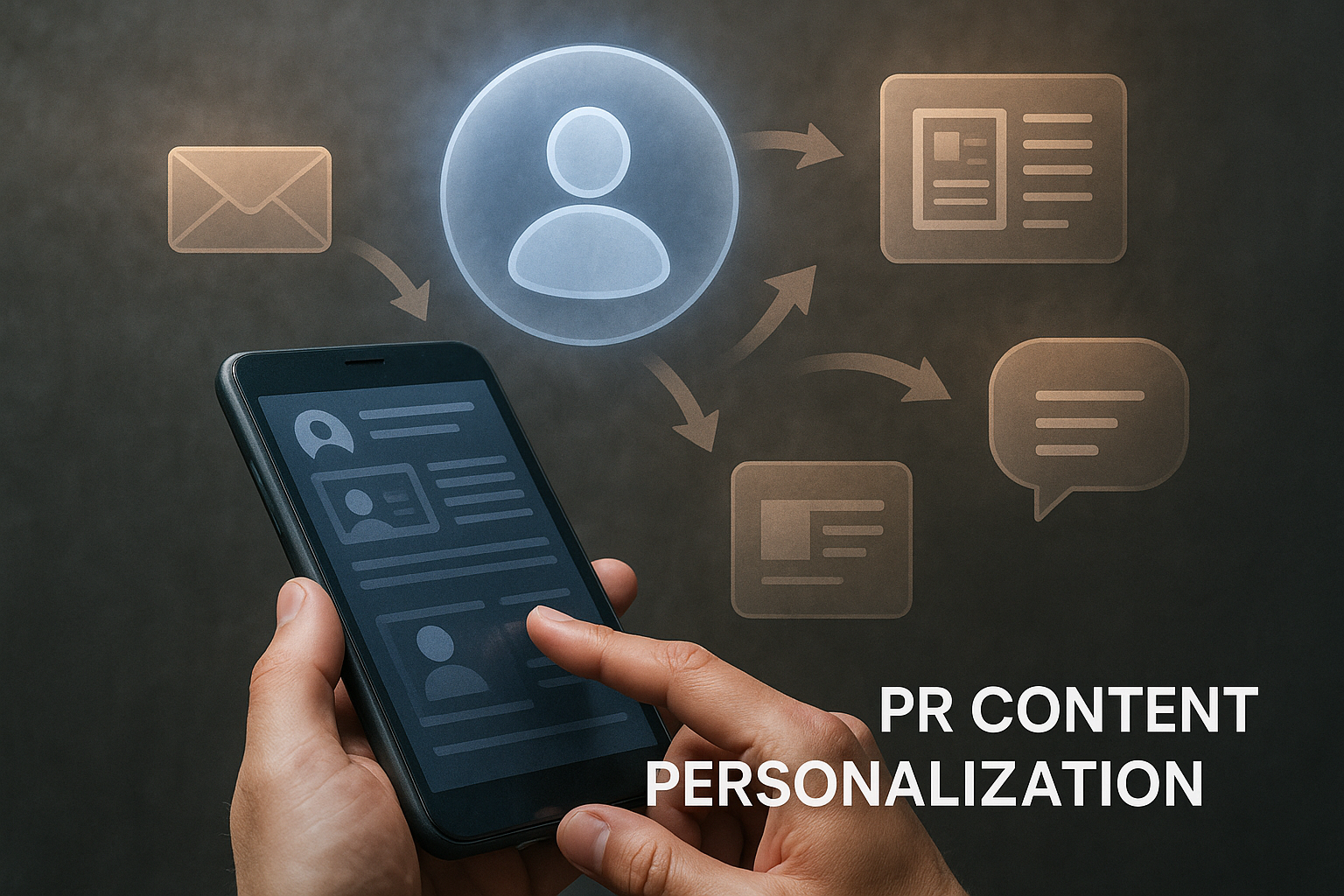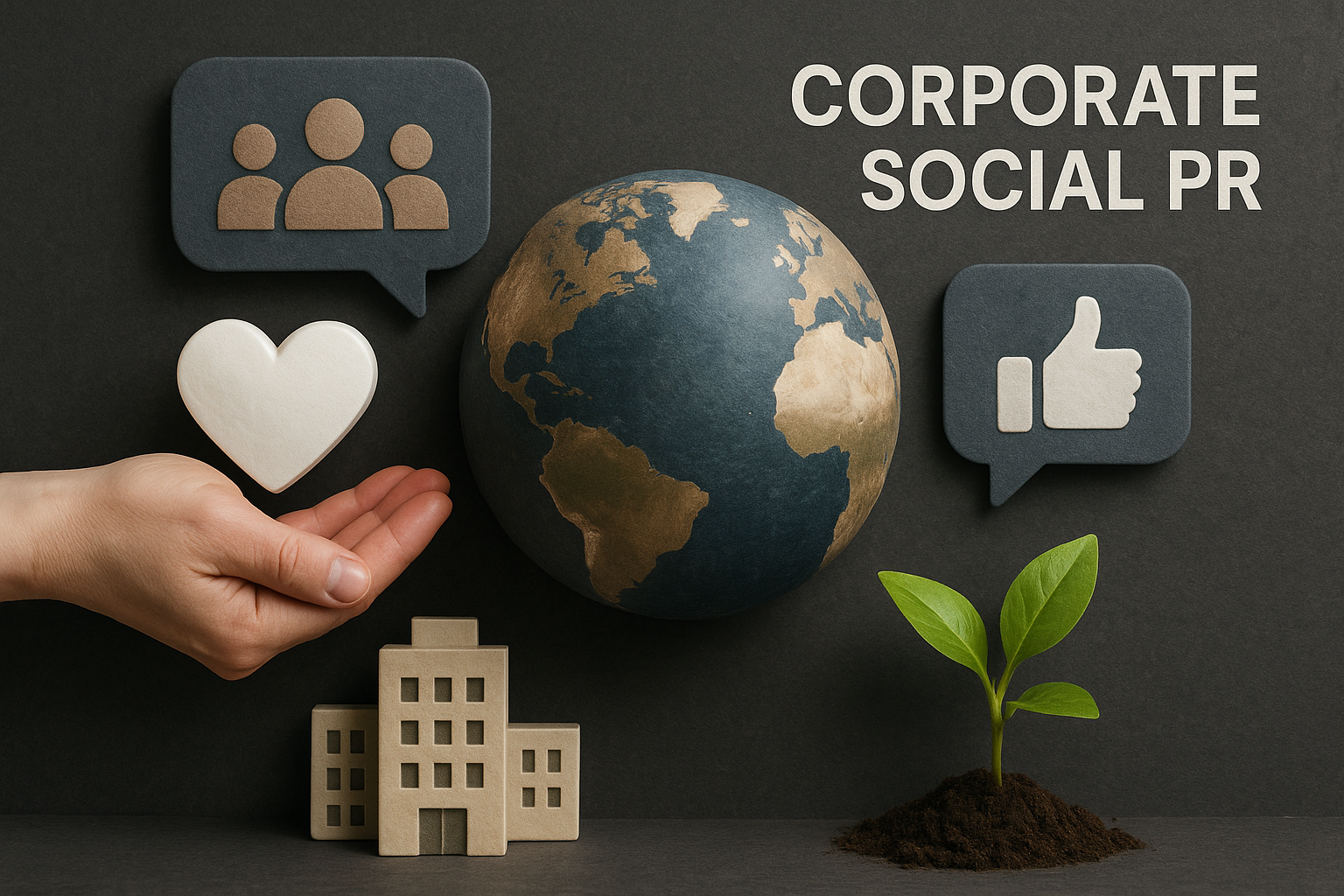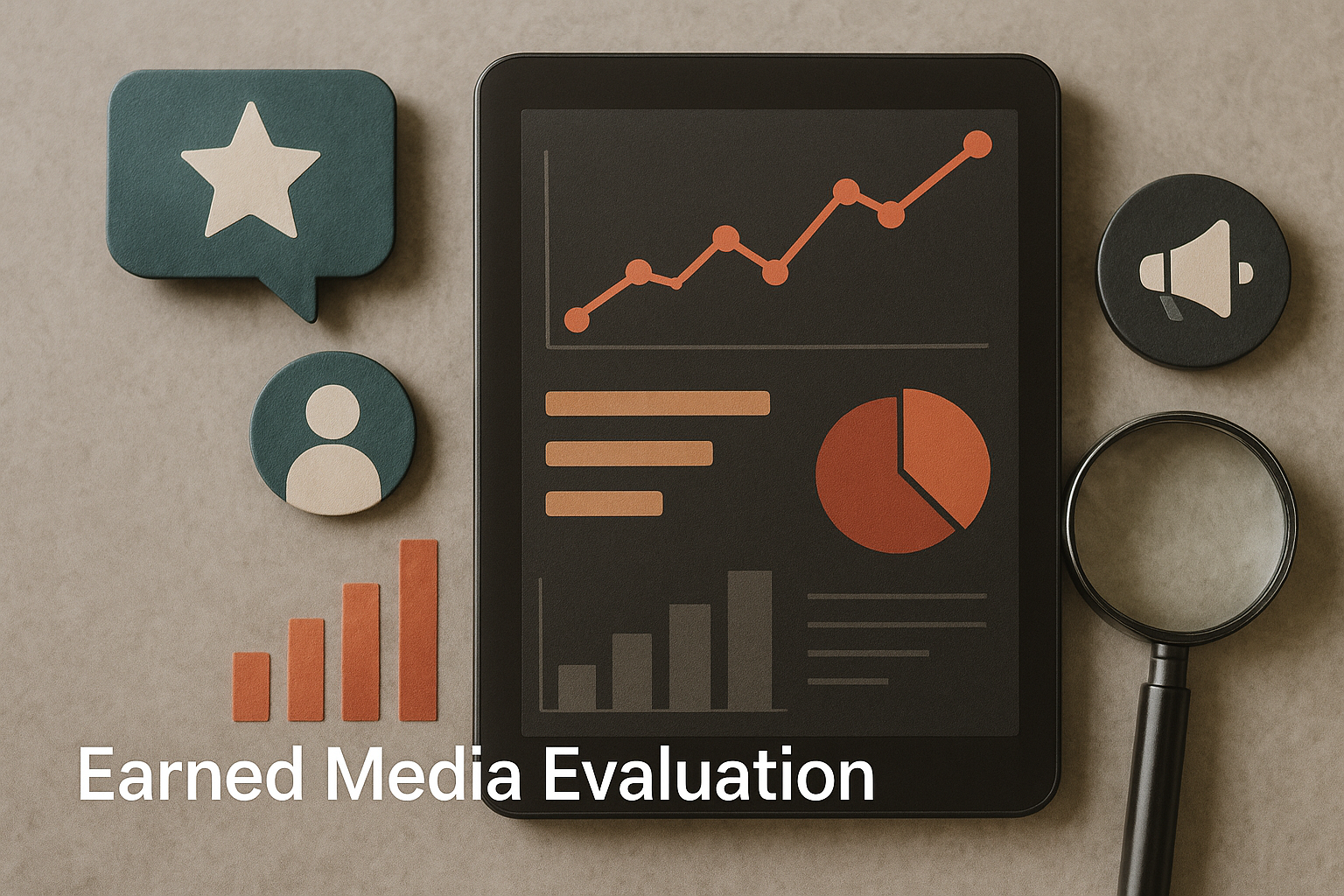PR for eCommerce is the key to building trust, driving visibility, and helping online stores stand out in today’s crowded digital marketplace.
It’s not just about selling products anymore. In the crowded world of digital retail, attention is the real currency. You can have the best store design, sharp ads, and even unbeatable prices, but without trust, it all fades. That’s where PR for eCommerce steps in.
Think of it as the bridge between your brand and the people who need to hear about it. It’s more than press releases, more than a few likes on social media. It’s the stories, mentions, and conversations that give your online store credibility. When shoppers see your name in the right places, it feels different. It feels real.
And here’s the truth: competition online is only getting louder. Every click leads to another shop, another discount, another option. Good PR is what makes your brand stand out in that noise. It builds reputation, sparks curiosity and it keeps your audience coming back, not just once, but again and again.
In the end, PR doesn’t replace marketing, it amplifies it. It adds depth, it adds trust, and it gives your store a voice that can’t be ignored.
What Is PR for E-Commerce?

It sounds simple on the surface, but it runs deeper than most think. PR for eCommerce isn’t just a fancy way of saying “get mentioned online.” It’s the art of shaping how people see your store, your products, and your story. And in a space where trust often decides who wins the sale, that art matters more than ever.
More Than Marketing
Marketing shouts. PR whispers. Marketing is about reaching people directly through ads, emails, and discounts. PR, on the other hand, works in the background. It builds credibility when others talk about you, not just when you talk about yourself. That mention in an article, a feature in a digital magazine, or a podcast spotlight those carry weight. They don’t feel like sales. They feel like validation.
The Digital Shift
Traditional PR once lived in print newspapers and glossy magazines. Today, it’s gone digital. Online stores fight for attention in blogs, social media feeds, influencer channels, and even YouTube reviews. Every tweet, every story, every post can shape reputation. And the beauty is, digital PR isn’t locked into one format. It adapts, flexes, and grows with the platforms your audience actually uses.
Why It Matters for Online Stores
Here’s the catch: customers can’t touch or feel your products before buying. They rely on signals: reviews, stories, mentions, and coverage. PR becomes the trust-builder. It takes your brand from being just another shop on the internet to something with authority. And when trust grows, conversions follow.
Think about it. Two stores sell the same product. One has media mentions, influencer collaborations, and customer stories floating around. The other doesn’t. Which one feels safer to buy from? The answer is almost always the first.
Connecting PR to Growth
PR is often misunderstood as “just getting press.” But for eCommerce, it’s growth fuel. It increases awareness, earns backlinks that boost SEO, and sparks conversations that keep your brand relevant. When done right, it becomes part of the sales engine just not in the obvious way ads do.
For example, when a product launch gets covered by a well-known blog, the traffic spike is real. When an influencer casually shares your brand story, the credibility it builds is priceless. Each mention is like a vote of confidence, stacking up over time until your store stands taller than the rest.
The Blend With Other Strategies
Here’s where it gets interesting. PR doesn’t live alone. It blends with content marketing, SEO, influencer marketing, and even customer service. One fuels the other. A good PR story feeds content. Content builds SEO. SEO drives traffic. And the cycle keeps spinning.
Companies like Impact Authority have shown how powerful this blend can be. By weaving PR efforts with digital strategies, they’ve turned online brands into names people actually recognize. That recognition is what makes PR worth the effort it’s long-term equity, not just short-term clicks.
Investor Relations PR vs. E-Commerce PR
At first glance, Investor Relations PR and eCommerce PR might seem worlds apart. One talks to investors, the other to customers. Yet, the principle is the same: building trust through consistent, authentic communication. For eCommerce brands, the “investors” are really the shoppers putting their money and confidence into your products. The medium changes, but the heart of PR stays steady.
Wrapping It Up
So, what is PR for eCommerce? It’s not a campaign, not one press release. It’s the ongoing work of shaping perception. Moreover, it’s the trust-builder that stands beside your ads, your SEO, and your content. And while marketing drives awareness, PR cements reputation. Together, they turn online stores into brands people not only notice but believe in.
The Core Goals of E-Commerce PR

PR can feel like a big umbrella, but for online stores, its goals are surprisingly clear. It’s not about vanity. It’s about building something that lasts a reputation, a voice, a brand people actually trust. Let’s break it down.
Building Trust First
Trust is the foundation. Without it, clicks don’t convert. People hesitate when they don’t know your name or haven’t heard about your brand elsewhere. PR solves that. When your store shows up in media stories, gets mentioned by bloggers, or finds its way into influencer conversations, it signals reliability. Customers don’t see just another shop; they see a brand worth their money.
Creating Real Credibility
Trust and credibility aren’t the same. Trust is emotional. Credibility is proof. Good PR delivers both. Features in respected outlets, product reviews from trusted voices, or even a quote in an industry piece they all add weight. They tell shoppers, “This brand belongs here. It’s not a fly-by-night operation.” For an eCommerce business, credibility can be the difference between a one-time buyer and a loyal fan.
Driving Awareness Where It Counts
No one can buy from you if they don’t know you exist. Awareness might sound simple, but it’s layered. PR doesn’t just spread your name; it puts it in the right places. Online magazines, niche communities, trending conversations that’s where awareness matters most. With PR for eCommerce, visibility comes with purpose. It’s not about reaching everyone. It’s about reaching the people who are most likely to care.
Strengthening Long-Term Loyalty
One sale is good. Repeat sales are better. Loyalty is where real growth hides. PR helps shape the stories that keep people connected even after checkout. A heartfelt founder interview, a sustainability feature, or a behind-the-scenes story these create emotional ties. And when buyers feel connected, they don’t just come back. They bring others with them.
Protecting Reputation in Rough Times
No brand is perfect. Mistakes happen. Products get delayed, reviews go sour, campaigns flop. This is where PR steps in as a shield. Having strong media relationships and a clear voice makes it easier to handle tough moments. Quick, honest communication can turn criticism into respect. And sometimes, a well-managed crisis even strengthens your brand.
Fueling Growth Beyond Ads
Ads can bring clicks. But PR brings depth. It amplifies everything else you’re already doing marketing, SEO, content. A good media mention not only drives traffic but also builds backlinks, which boost rankings. That’s growth that sticks. Over time, PR compounds. Each story, each mention, each review adds another layer until your brand feels established, even in a crowded market.
Tying It All Together
So, the core goals of eCommerce PR aren’t complicated. Build trust. Earn credibility. Drive awareness. Protect reputation. Strengthen loyalty. And in doing all of that, fuel sustainable growth. It’s less about short-term wins and more about creating a presence people believe in.
When done right, PR doesn’t just sit beside marketing it powers it. It takes your campaigns, your content, your ads, and gives them a stronger backbone. And in the end, that’s what makes your store not just visible, but unforgettable.
Digital Retail Public Relations: The New Frontier
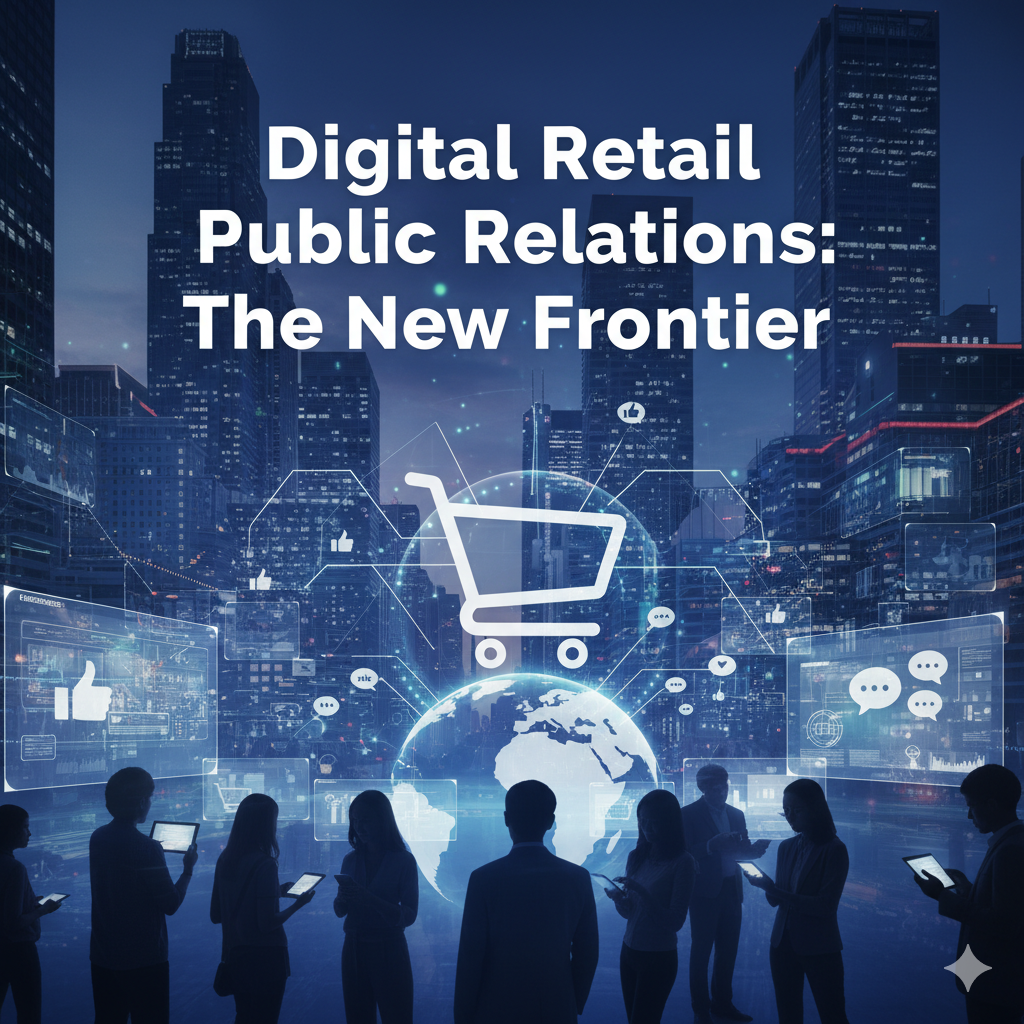
The way people shop has changed forever. Walking into a store is no longer the default. Clicking into one is. That shift has transformed not just retail but the way brands need to communicate. And at the heart of that shift is digital retail public relations.
From Traditional to Digital
PR used to mean newspaper clippings, glossy magazine features, and maybe a spot on TV. That still matters, but it’s no longer enough. Online stores live in a different universe: fast-moving, competitive, and global. Digital PR is built for that world. It lives on blogs, social feeds, podcasts, influencer shoutouts, and digital news sites. It’s faster, sharper, and designed to meet customers where they already are on their screens.
More Than Just Mentions
It’s easy to think PR is only about coverage. But in eCommerce, it’s much more. It’s about weaving your brand into the conversations people are already having. When shoppers scroll Instagram, read a niche blog, or listen to a podcast, they don’t want ads, they want stories. Digital retail public relations steps in by shaping those stories in ways that feel natural. It doesn’t push; it pulls.
The Role of Social Proof
Here’s where it gets interesting. Online, social proof is everything. Reviews, testimonials, influencer recommendations these are the new billboards. They don’t just catch attention; they build trust. PR for eCommerce taps into this by amplifying voices outside the brand. Instead of saying “we’re great,” it helps others say it for you. And that’s infinitely more powerful.
Agility in Action
The digital space doesn’t wait. Trends rise and fade overnight. Hashtags come and go. They flare up, burn bright, and disappear in hours. But the right PR move? That can drop your brand right into the middle of it all. Maybe it’s jumping on a viral thread. Maybe it’s answering a cultural moment. Or maybe it’s just rolling out a fast campaign when a shopping wave hits. Whatever it is, being quick on your feet is what makes the difference. Traditional PR takes weeks. Digital PR? It can happen in hours.
Storytelling That Travels
Another strength of digital PR is reach. A story in a local paper stays local. But an online story? It can spread across borders instantly. For eCommerce brands, that reach is gold. You’re not tied to one city or one country. You can tell your story once and see it ripple across markets you’ve never even stepped into.
Why It Matters Now
Competition online? It’s not easing up anytime soon. New shops pop up every day, selling the same stuff, chasing the same clicks. What really sets one apart isn’t always what’s in the cart, it’s the story wrapped around it. And that’s where digital retail public relations steps in. It makes sure that story isn’t just told, but seen, heard, and remembered. It makes your brand more than just a shop and makes it a name people trust.
The Takeaway
The frontier of PR has moved. It’s no longer limited to press releases and clippings. It’s dynamic, digital, and always moving. And for online stores, embracing that shift isn’t optional, it’s survival. With the right digital PR strategy, you don’t just join the noise. You rise above it.
Online Store Brand Promotion Strategies

Promotion isn’t a volume game. Shouting doesn’t stick. Being remembered does. For online stores, that means more than grabbing eyes, it means building a connection that lasts. And let’s be honest, shoppers move fast. They scroll faster, they click without thinking, and they forget even quicker. So the real question is how do you stay in their heads when the feed keeps moving?
Start With the Story
Every strong brand begins with a story. Not just what you sell, but why you sell it. Was it born from solving a personal problem? Was it built on a mission? Shoppers care about these details more than you think. A clear story gives your brand a human side. And when PR for eCommerce amplifies that story, it transforms from a product pitch into something people want to follow.
Use Social Media as a Stage
Social platforms aren’t just marketing channels, they’re stages for brand storytelling. Instagram posts, TikTok reels, LinkedIn updates all play a role. But here’s the trick: it’s not about being everywhere. It’s not about showing up everywhere. It’s about showing up where your people actually spend time. Maybe that’s a quick behind-the-scenes clip. Maybe it’s giving a customer a shoutout. Or even throwing up a poll just to see what they think.
Used right, social media isn’t just a sales floor. It’s a conversation. A back-and-forth that keeps folks around, not because you’re selling hard—but because you’re actually engaging
Align PR With Product Launches
Timing matters. New product? Big sale? Holiday campaign? These are perfect chances to blend PR with promotion. Instead of relying only on ads, pair launches with press releases, influencer teasers, or blog features. This way, excitement spreads beyond your own channels. Suddenly, your product feels like news, not just another listing.
Tap Into Influencers and Creators
Influencers aren’t only about numbers. Let’s be real, anyone can buy followers. What matters is the trust behind them. People stick around because they like the person, because the advice feels real. Not like another ad stuffed in the feed.
So, when you team up with the right voice, your product doesn’t feel forced. It just slides in, like a friend’s tip. And honestly, that’s where micro-influencers shine. Smaller audience, sure. But the bond? Way stronger. For online store brand promotion, that kind of connection is worth a lot more than a giant crowd that barely cares.
Blend Promotions With Purpose
Shoppers care about values. Sustainability, inclusivity, and fair practices matter. Promotion that highlights purpose often resonates stronger than a discount ever will. If your store plants a tree for every order or supports local makers, make it part of your PR story. It doesn’t just sell products; it builds loyalty.
Create Evergreen Content
Not all promotions have to be time-sensitive. Evergreen content blogs, guides, tutorials keep working long after it’s published. A style guide, a buying checklist, or even a “how to use” video can drive traffic for months. And when those pieces get shared or mentioned by others, they double as subtle PR wins.
Keep Testing and Adapting
No strategy is perfect forever. Algorithms shift, audiences move, trends change. That’s why promotion strategies need flexibility. Try new formats, experiment with collaborations, and track what actually works. The more you test, the faster you find the sweet spot that keeps your brand relevant.
Promotion isn’t about pushing harder. It’s about connecting smarter. When you mix storytelling, social engagement, influencer trust, and purpose-driven campaigns, your store becomes more than a place to shop. It becomes a brand people recognize, talk about, and return to. That’s the real power of online store brand promotion turning visibility into long-term connection.
E-Commerce Media Outreach That Works

Media outreach. Sounds formal, doesn’t it? In reality, it’s not about blasting press releases into the void. It’s about conversations. It’s about people. And if you run an online store, those people matter more than you think.
Think about it. Journalists, bloggers, and influencers all act as bridges. One good mention can place your brand in front of thousands of potential buyers who didn’t even know you existed. That’s the magic of e-commerce media outreach. But, of course, it doesn’t happen by accident.
Forget the One-Size-Fits-All Approach
Here’s the thing: nobody wants to feel like a name on a list. Yet, that’s exactly what so many brands copy, paste, send. And then wonder why nobody replies. Instead, slow down. Read the journalist’s last few stories. Watch how that influencer talks to their followers. Tailor your pitch like you’re writing to a friend. Because in a way, you are.
Tell Stories, Not Just Stats
People don’t wake up in the morning hoping to read about your “latest product features.” They want stories. Why did you launch this product? What problem it actually solves. How it makes life easier, faster, or even just more fun. Stats can support the story, sure—but they can’t replace it.
Timing Is Everything
Ever notice how some news just fades into the noise, while other stories catch fire? Timing. Release your pitch too early and people forget. Too late and you miss the wave. The sweet spot is where your story connects with what’s already being talked about. A trend. A holiday. A conversation that’s already buzzing.
Build Relationships Before You Need Them
Here’s a little secret about PR for eCommerce: the best pitches aren’t cold. They’re warm. They come from relationships you’ve been building over time. A comment on LinkedIn. A thoughtful reply to a tweet. A quick “loved your piece on X.” Do this consistently and when your email finally lands, it doesn’t feel like spam, it feels like a continuation of a conversation.
Don’t Chase Everyone, Chase the Right Ones
Not every outlet is worth your time. A shout-out from a small but passionate niche blog might bring you more sales than a mention in a huge, generic magazine. Why? Because the readers are your readers. Relevance beats reach almost every time.
Media outreach isn’t just about getting press. It’s about weaving your store into the conversations that people already care about. And if you get it right your brand doesn’t just show up. It sticks.
Influencer & Creator PR for Online Stores

Scroll through Instagram. Open TikTok. Hop onto YouTube. Everywhere you look, there’s someone showing off a product. Not a billboard. Not a TV ad. A person. Someone talking, unboxing, reviewing. And people listen. That’s the power of creators. For online stores, this kind of PR isn’t optional anymore. It’s survival.
Why Creators Matter More Than Ads
Let’s be honest, ads are easy to skip. Scroll, skip, mute, done. But when your favorite creator says, “I tried this,” you stop. You listen. And maybe you buy. Influencers bring something traditional ads never could: trust. Their followers see them as friends, not sales reps. That’s why creator partnerships can flip the switch for an e-commerce brand.
Finding the Right Voices
Not every influencer fits your store. Big names with millions of followers look tempting, but sometimes smaller creators the ones with tight, loyal communities deliver more. They speak directly to the people who care. Micro and nano-influencers might not flood you with likes, but they often bring real sales. Quality over quantity, always.
Build Real Relationships, Not Transactions
Here’s where many brands mess up: they treat influencers like vending machines. Pay, post, goodbye. That doesn’t work anymore. People spot forced endorsements from a mile away. Instead, talk to creators like partners. Share your story. Involve them in the process. Let them create in their own voice. When it feels natural, their audience feels it too.
Storytelling Beats Scripts
Forget pushing a script. Influencers know how to talk to their audience better than you ever will. Give them space. Maybe it’s a behind-the-scenes video. Maybe it’s a day-in-the-life post. The goal is authenticity. Because when the story feels real, the brand feels real.
Long-Term Beats One-Offs
One post? It fades. A long-term collaboration? That sticks. Consistent mentions build recognition, and recognition builds trust. If a creator keeps showing your product over time, followers start to think, “Okay, maybe I should try this.” That’s the moment your brand crosses from stranger to familiar face.
PR for eCommerce Meets Influence
This is where PR and creator culture collide. It’s not just about getting attention, it’s about shaping perception. A feature in a magazine builds credibility. A shout-out from a trusted creator builds connection. Together, they make a brand feel bigger than it is.
Influencers and creators aren’t just the future of promotion. They’re the present. They’re where your customers are spending time, forming opinions, and making decisions. Get this part right, and your online store doesn’t just sell more it becomes part of the conversation.
Crisis Management in E-Commerce PR

Things break. Orders get lost. A server goes down during a big sale. A review blows up on social media and suddenly the whole internet is talking. That’s e-commerce. You can’t dodge every problem. But you can decide how you show up when it happens. And often, that’s the difference between losing trust or building it.
When Trouble Moves Faster Than You Do
Crises don’t wait for a press release. They move quickly. One customer post can turn into a trending hashtag before you even sip your morning coffee. And if your brand stays silent? People assume the worst. A fast reply even if it’s short tells customers you’re present. Listening. Trying.
Don’t Overcomplicate the Truth
Here’s the mistake many make: covering the issue in shiny words. Customers see right through that. What works better? Plain honesty. Admit the problem. Explain it without jargon. Say what you’re fixing. It may sting at first, but people respect a brand that owns its mess.
Planning Beats Panic
You can’t script every crisis. But you can prepare. Decide early who speaks for your brand. Draft possible responses. Set up a system for monitoring mentions. Because in the middle of chaos, you don’t want to scramble for a plan you want to hit play.
Keep It Human, Always
No one warms to “corporate language.” Not in a crisis. Customers don’t want carefully polished statements. They want empathy. Real words. Something like: “We messed up, here’s how, and here’s what we’re doing.” A sincere apology lands better than the best spin.
Lessons Hidden in the Mess
Every storm leaves clues. Maybe shipping needs better partners. Maybe support needs faster scripts. Or maybe your policies just confuse people. Whatever it is, you dig into it after the dust settles. Then fix it. Because the worst kind of crisis? The one that repeats.
Where PR for eCommerce Steps In
And this is where PR for eCommerce proves its worth. Good PR cushions the blow, controls the narrative, and makes sure your side of the story gets told. Even more, it helps rebuild once the storm has passed. Done right, PR doesn’t just protect your brand it can even turn a bad moment into a trust-building one.
Crisis management isn’t about pretending mistakes never happen. They always do. It’s about handling them with speed, honesty, and a human touch. Do that, and you don’t just protect your reputation, you give people another reason to believe in you.
PR Tools & Channels for E-Commerce Brands

Running a store online means shouting into a very crowded room. Everyone’s talking. Everyone’s selling. The trick is finding the right microphone and the right stage. That’s where PR tools and channels come in. They don’t just spread your message. They decide who hears it, how often, and what they remember.
Press Releases: Old but Gold
Yes, press releases still work. Not the stiff, lifeless kind, though. The good ones tell a story about a launch, a milestone, or even a shift in direction. They give journalists something solid to work with. And when picked up, they can land your store in places ads never could.
Social Media: The Frontline
Let’s be real. Most of your customers will meet your brand on social media first. Instagram, TikTok, X pick your platforms wisely. Each one plays by different rules. TikTok loves trends. Instagram loves visuals. X loves speed. The right mix keeps your brand voice alive and consistent. It’s not just posting a conversation. Replying, reacting, joining in.
Email: Quiet but Powerful
Social feeds come and go, but inboxes stay. A well-crafted email campaign can nurture customers long after the first click. PR for eCommerce isn’t only about going wide; sometimes it’s about going deep. Emails let you speak directly, without algorithms deciding who sees what.
Blogs & Owned Content
Your website shouldn’t just push products. It should tell stories. A blog post, a quick guide, even a behind-the-scenes update, it all adds up. You get to shape the narrative instead of waiting for someone else to tell it.
Think of it like running your own small newsroom. You pick the headlines, you decide what matters. And if you sprinkle in some smart SEO? Those stories don’t just sit on the shelf. They pull in traffic, bringing new eyes right to your door.
Partnerships & Collaborations
Funny thing, sometimes the best way to get heard isn’t by shouting louder. It’s by teaming up. Join forces with another brand. Run a campaign together. Or pull in a creator to share the spotlight. Suddenly, your reach doesn’t just add up, it multiplies. The bonus? Their trust rubs off on you. Customers think, “If they’re working together, maybe I should pay attention.”
The Media Mix That Works
No single channel carries everything. Press releases build credibility. Social media fuels conversation. Emails deepen the bond. Blogs anchor your voice. Partnerships expand reach. Each plays a part. But the magic? It’s in how they fit together. A smart blend creates a rhythm that keeps your brand visible and believable.
At the end of the day, tools and channels are just that tools. What matters is how you use them. With the right mix, PR for eCommerce doesn’t just get your store noticed. It keeps people talking, sharing, and coming back.
Measuring PR Success in Digital Retail

Here’s the thing: PR isn’t like sales. You can’t just look at a receipt and know it worked. Success in digital retail PR feels fuzzier at first glance. But the truth is, it can be tracked. You just need to know what to look for. Numbers help, but so do stories. Together, they tell the real picture.
Beyond Just Buzz
Sure, mentions matter. Getting your online store in the press or on social feeds looks good. But volume isn’t everything. What counts is tone. Are people praising? Complaining? Asking questions? Buzz without trust fades fast. PR wins when your name shows up in the right places, with the right vibe.
Traffic That Tells a Story
Check your site analytics. Did visits spike after that article dropped? Or after a creator posted your product? That’s PR at work. But don’t stop at clicks. Look at what visitors do next. Do they bounce? Or do they explore? Quality traffic people who actually stick around matters more than raw numbers.
Engagement Over Eyeballs
It’s easy to chase. But 10,000 views don’t mean much if no one interacts. Comments, shares, sign-ups that’s real engagement. It shows people aren’t just seeing your brand. They’re connecting. That connection, over time, is what drives sales and loyalty.
Reputation You Can Feel
Not every result fits neatly into charts. Sometimes it’s in the shift of tone. Customers trust you more. Journalists call you for quotes. Influencers mention you without being asked. These moments prove your brand is becoming part of the conversation. That’s the hidden ROI of PR for eCommerce credibility that advertising can’t buy.
ROI: The Hard Numbers
Still, numbers count. Compare campaign costs against results: increased sales, lower ad spend thanks to organic mentions, stronger conversion rates. PR doesn’t always show direct sales spikes, but it creates an environment where sales happen easier and faster. That ripple effect is real.
The Mix That Matters
One metric alone won’t do it. You need a mix of coverage, traffic, engagement, reputation, and revenue. Together, they tell the story of whether your PR is moving the needle. Digital retail moves too fast for guesswork. Measuring isn’t just about proving success; it’s about improving the next campaign.
At the end of the day, PR isn’t just noise, it’s momentum. You track it through data, yes, but also through shifts you can feel: more trust, more conversation, more presence. When that balance shows up, you know your PR is working.
The Future of PR for E-Commerce
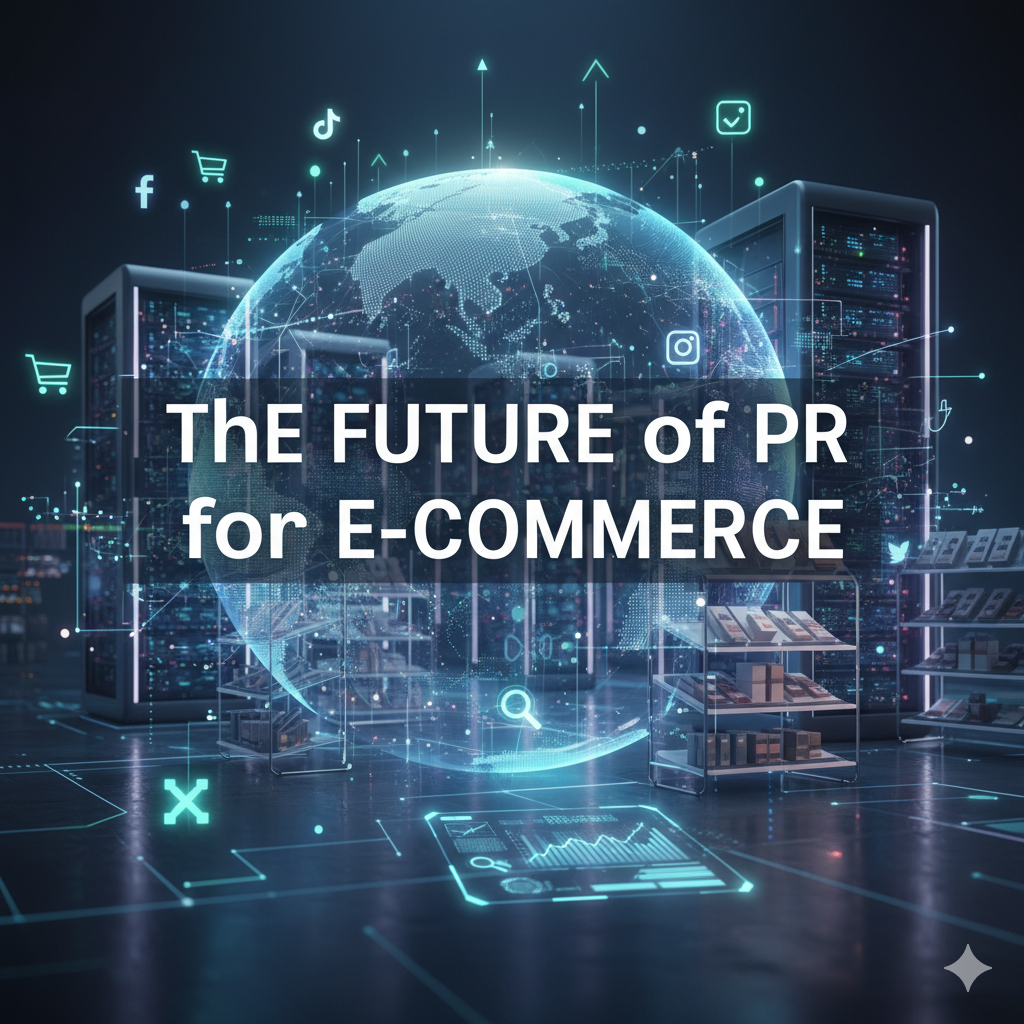
The internet doesn’t sit still. One week it’s memes, the next it’s micro-videos, and before you’ve even figured out the algorithm, the crowd has already moved on. PR gets caught in that current every single time. It can’t just “keep up”—it has to read the tide, maybe even spot the next wave before it crashes.
That’s the tricky part, and also the exciting one. The future of PR for eCommerce? It feels less like a plan on paper and more like surfing. Balance, quick reflexes, and a willingness to fall off and climb back on again.
Personalization Will Take Center Stage
Here’s something you’ve probably noticed yourself: most generic campaigns blur together. A banner flashes, a post scrolls by, and two seconds later you’ve forgotten it. But when a message feels like it knows you like it taps into what you actually care about, that’s when you pause.
That’s where PR is heading. Shoppers won’t just expect personalization; they’ll demand it. Not in the creepy “we know your search history” way, but in the sense of relevance. If sustainability drives your choices, the story should highlight that. If you value community, then show me how the brand builds one. One-size-fits-all? That’s fading fast.
Tech Won’t Just Help It’ll Drive
AI isn’t a distant possibility anymore. Neither is automation. Tools that once sounded futuristic are now baseline. Imagine a dashboard that listens to conversations across platforms, flags mood changes around your brand, and even suggests tweaks in real time.
That’s not sci-fi. It’s happening. But here’s the catch: the tech won’t tell the story for you. It can deliver timing, context, and reach. What it can’t replace is the spark—the human touch in the message itself. Without that, it’s just noise sent faster.
Platforms Come and Go
Do you remember when Facebook brand pages felt like the only thing that mattered? Or when Instagram grids were treated like museum walls? Now TikTok sets the rules. And something else will eventually replace TikTok too.
That’s the pattern. Which means clinging to one channel is dangerous. The future belongs to those who can shift, adjust, and speak the language of wherever people migrate next. A rigid plan won’t work. Agility will.
Trust Will Be the Dealbreaker
All the tools and platforms in the world won’t save a brand that loses trust. And trust is fragile. Shoppers trust reviews, real stories, even creators they’ve never met more than corporate voices. That’s just the reality now.
Which means PR for eCommerce has to lean harder on honesty. Not glossy spin, not over-promises—just transparency and stories that line up with reality. Once cracks show, the repair takes years, sometimes forever.
Partnerships Will Expand Reach
One more shift worth noting: collaboration. You already see brands teaming up with creators. Soon you’ll see more brand-to-brand partnerships, brand-to-community tie-ins, even unexpected alliances. Why? Because credibility spreads faster when it’s shared. If two trusted names vouch for each other, people listen. That’s leverage.
What It Really Comes Down To
So, what’s next? It isn’t about shouting louder. It’s about adapting quicker. Blending human creativity with sharper tools. Earning trust, not buying it. Platforms will rise and fade. Algorithms will change. But the core won’t budge: PR is still about conversations. The kind that feels real. The kind people want to join. And those conversations? They don’t go out of style.
Conclusion
So here’s the thing. PR for eCommerce isn’t some side task you check off a list. It’s the heartbeat of your store’s reputation. The way people see you, the way they talk about you yeah, that’s PR.
And sure, tools and tech will keep changing. Tomorrow it might be AI-generated shopping feeds or the next big platform nobody saw coming. But the core? It stays the same. People trust people. They want honesty. They want stories they can share without rolling their eyes.
Think about it. Customers don’t remember every ad. They remember how your brand made them feel. That’s where PR steps in not loud, not pushy, but steady. Building. Layer by layer.
At the end of the day, it’s not about being perfect. It’s about showing up, owning your voice, and keeping that trust alive even when things get messy. Because in this crowded digital market, trust isn’t just nice to have. It’s survival.

